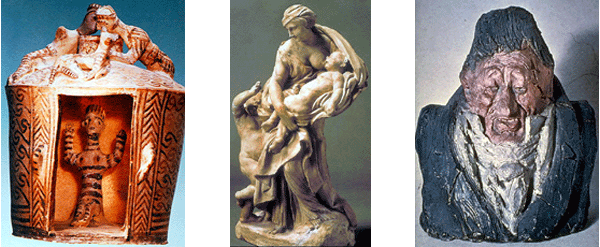

Page 2 of 4
Read the text and study the images below then move on to page 3.
2. Additive sculpture
Modelling

above left A clay
model of a shrine from the Minoan civilization - found at Archanes, Crete.
Dated to the Proto-geometric period (10th-9th century B.C.). Archaeological
Museum of Herakleion, Crete
above centre Gian
Lorenzo Bernini, the second terracotta bozzetto (model) for the
figure of Charity on the tomb of Urban VIII, 17th century. Vatican
Museum, Rome.
above right Honoré
Daumier, Monsieur Royer-Collard, clay sculpture, c. 1830-1839.
Private collection.
Solid Casting
To create a cast from a model, the artist makes a mould which is a 'negative' image of the sculpture. Most commonly, a mould is made of plaster, and taken from the surface of the model. This is then filled with molten metal, and the plaster broken away to leave a metal duplicate of the original model. The favourite metal for sculpture is bronze, which is an alloy of copper and tin. As metal is both heavy and costly, solid casts were made only for tiny works, and hollow metal sculptures were developed for larger sculptures.